Last weekend’s victory over Montpellier moved Stade Rennais to third in Ligue 1. Since losing two of their first four league matches, Les Rouge et Noir have remained unbeaten in all competitions. They have collected twenty-seven points after thirteen games in Ligue 1 and have enjoyed the best-ever start to a season in the club’s history
They are currently on a five-match winning streak and have a great chance to extend that run as they face Lille and Toulouse before the mid-season break. As we enter this weekend’s fixtures, they are the second most in-form team in Europe’s top five leagues behind Napoli.
This article will be a tactical analysis in the form of a scout report that focuses on the tactics deployed by Bruno Genesio’s team so far this season. We will thoroughly analyse the team’s attacking and defensive tactics and look at how the team sets up in transition.
Attacking approach
Rennes’ attacking play is focused on maintaining possession and building their attacks progressively through each third of the pitch. So far this season they have averaged 57% possession which is the joint third-highest in Ligue 1.
When they attack, they will aim to dominate as high up the pitch as possible, making the pitch as wide as possible. As Bruno Genesio is a disciple of the positional play approach Rennes look to create superiority through overloads, 1v1’s and getting their players into pockets of space between and behind their opponent’s defensive lines.
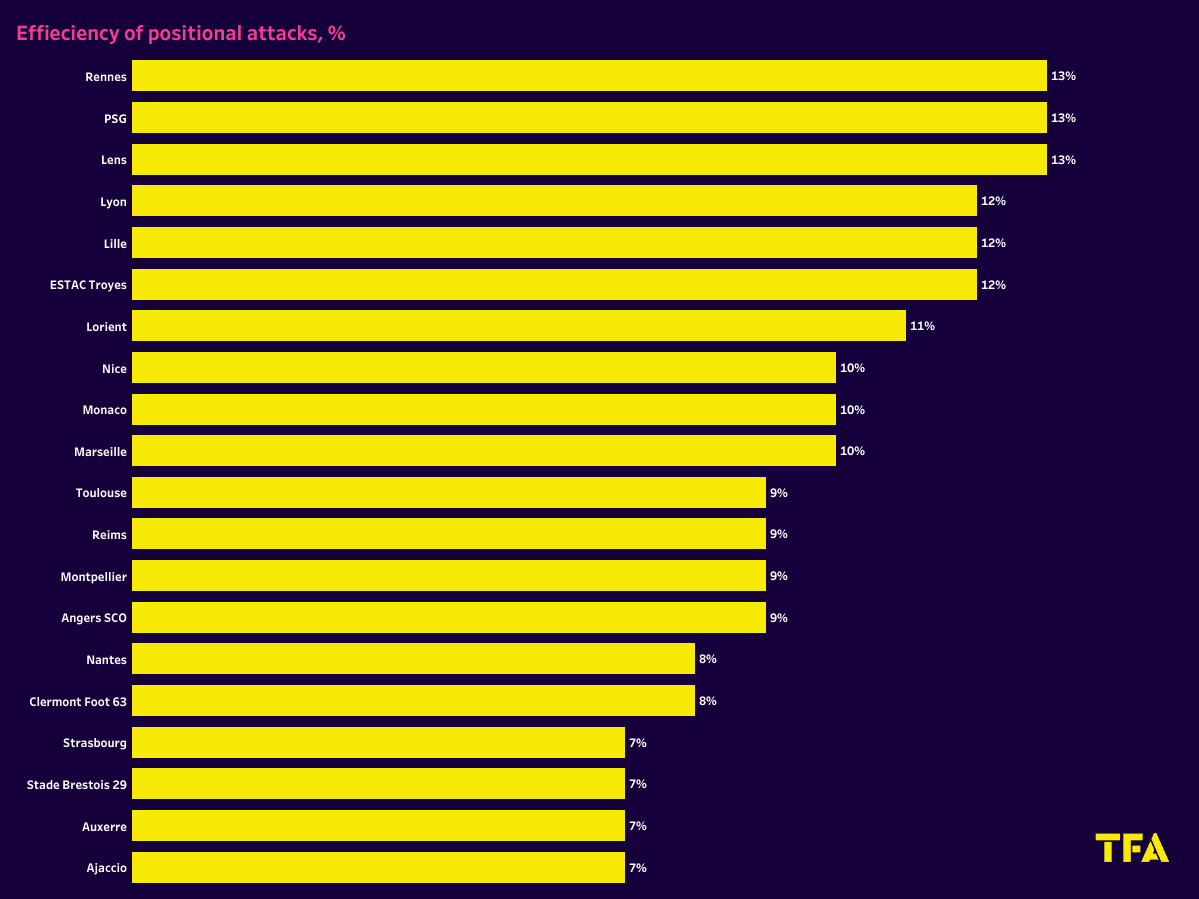
The chart above shows the efficiency of each team’s positional attacks in Ligue 1 this season. Rennes are joint top along with PSG and Lens.
This shows they are being purposeful and effective in possession. They have scored the second-highest number of goals with twenty-eight, and they are averaging 2.02 goals per 90 minutes and have an expected goals amount of 27.3
Build up
Their positional attacks start in their defensive third as they look to play out through the defence. The image below shows how Rennes are positionally set up as they play out from the back.
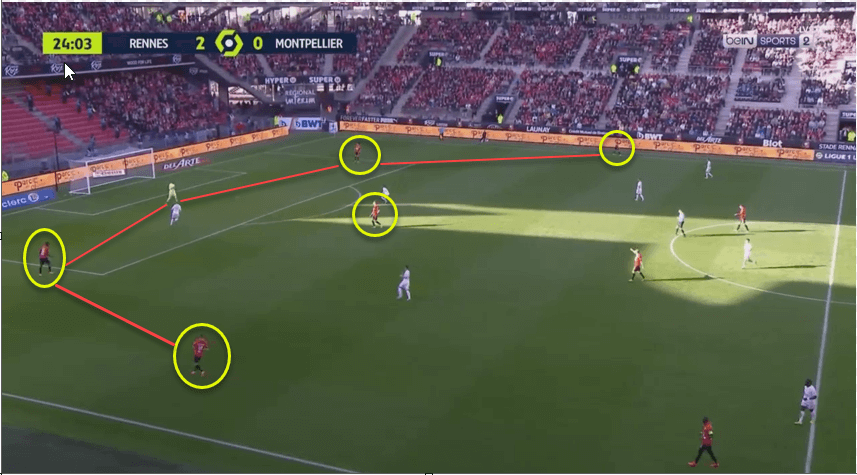
You can see how the centre-backs split, the number six drops and the full-backs push high and wide to give the team full coverage of the pitch. There are several reasons for this approach.
- It maximises the opportunities to be progressive straight from the goalkeeper, both in the first phase and second phase of the build-up
- It attracts the opposition closer to the ball and further away from their own goal as they try to stop Rennes from building up.
- It creates bigger spaces with the opponent’s defensive shape both horizontally and vertically.
When the centre-backs split to receive the ball, they act as a decoy to enable Rennes to play with more verticality.
Rennes’ primary tactic is to play straight from the goalkeeper to the full-backs, with the full-backs then progressing the team straight into the opponent’s half.
The pass map below shows all the successful passes Rennes goalkeeper Steve Mandanda has completed in Ligue 1 this season. As the map shows, there is a big emphasis on him passing to the wide areas.
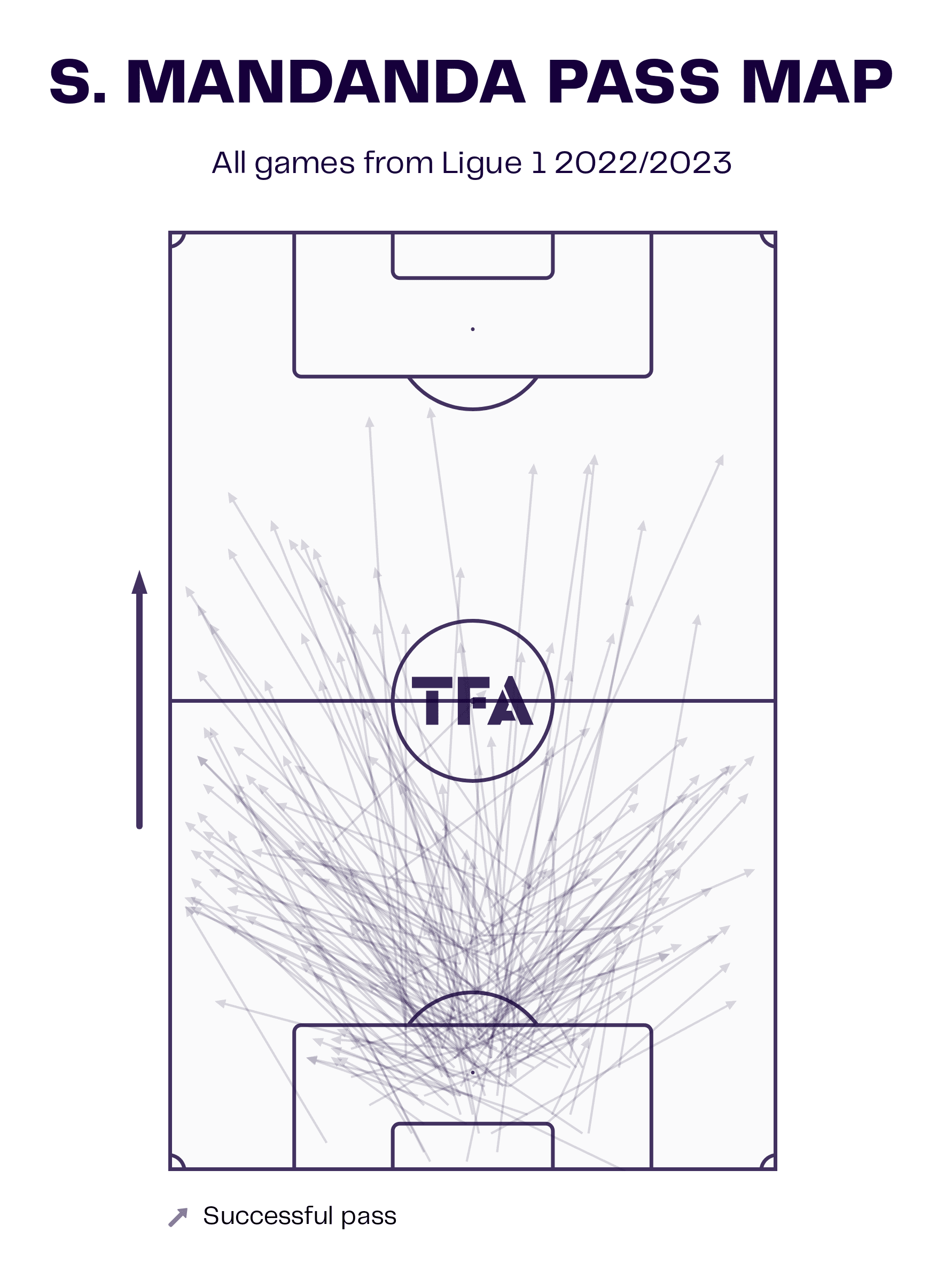
Attacking third
Rennes set up with a 4-4-2 formation, with the 4-3-3 being the preferred secondary option. However, both these formations are the team’s defensive shapes. In possession, Bruno Genesio has Rennes switching to a 3-2-5 attacking shape as they impose themselves in the other team’s half and approach the attacking third.
The 3-2-5 shape supplements the positional play approach, allowing Rennes to have a player in every zone across the pitch.
The image below shows their attacking shape as they approach the attacking third. This image shows Rennes building down the right-hand side. You can see the benefit of their positional approach as they can pin Montpellier’s defence right back and match them numerically.
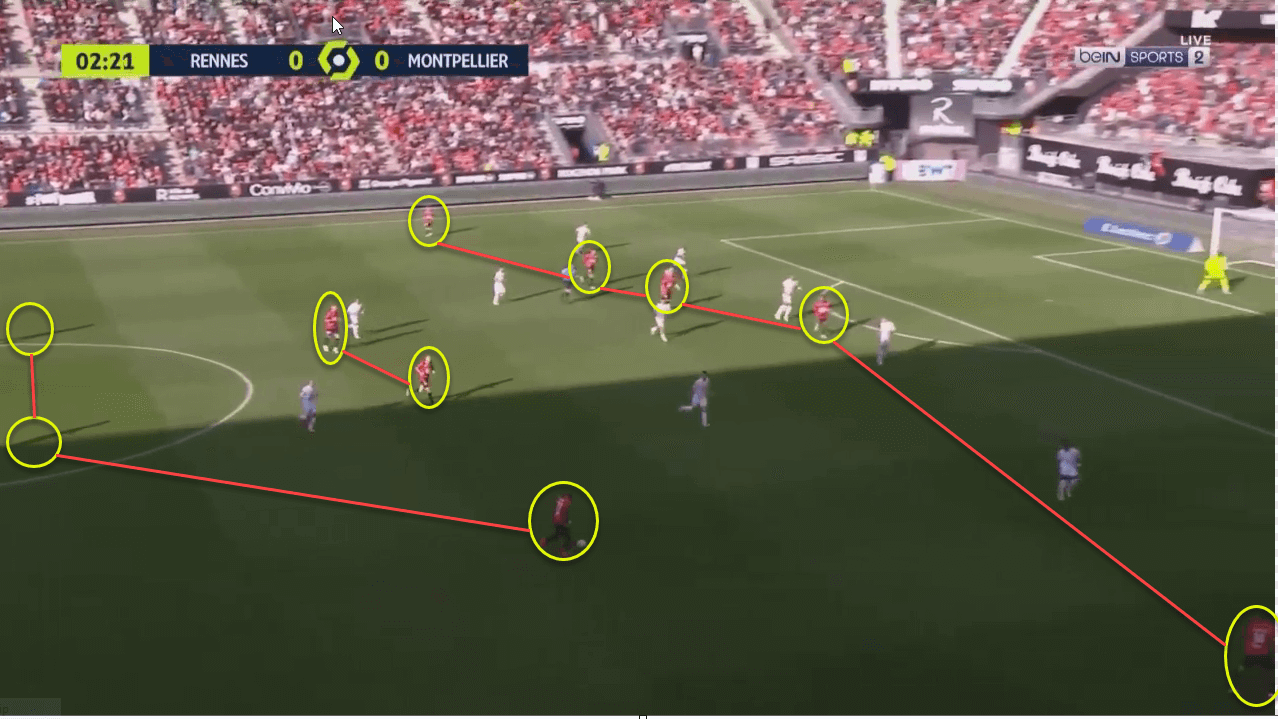
The three-man defence is made up of two centre-backs and a full-back, with the other full-back joining the attacking line. The decision on which full-back remains and which joins the attack is decided on what side they play through.
The image below shows how Rennes balance the attacking shape. You can see how the defending fullback comes inside to sit narrower.
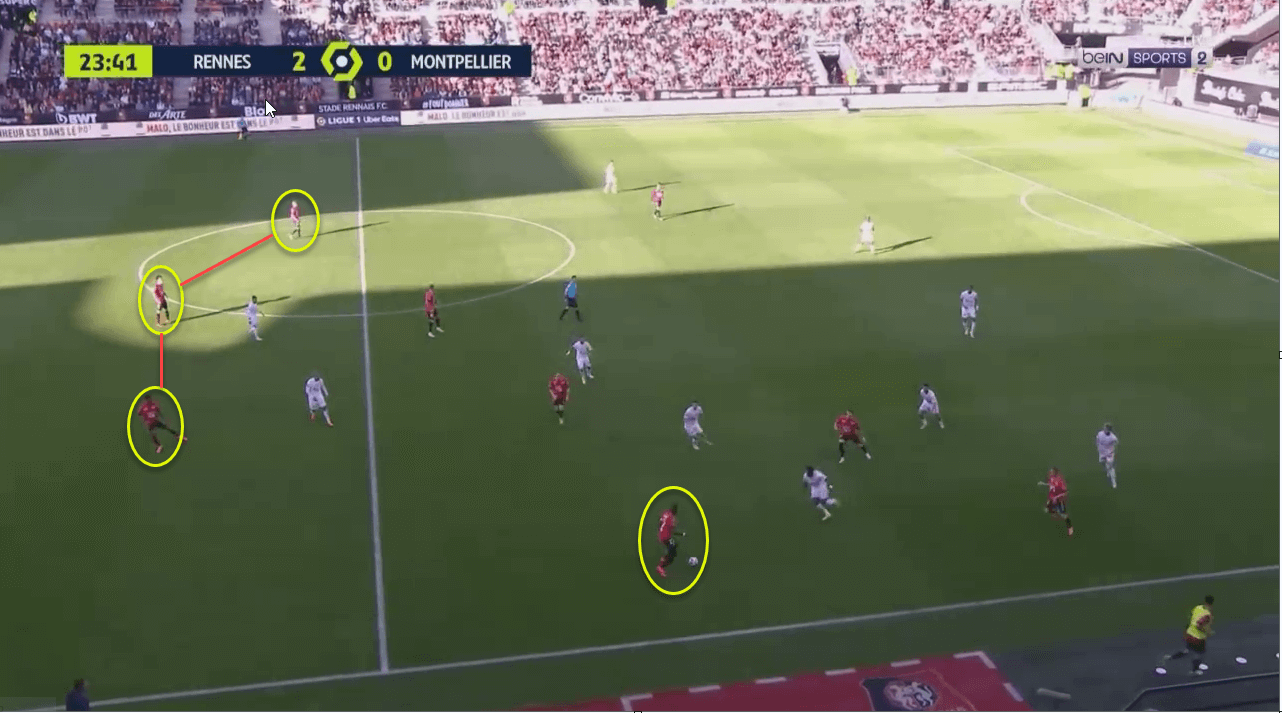
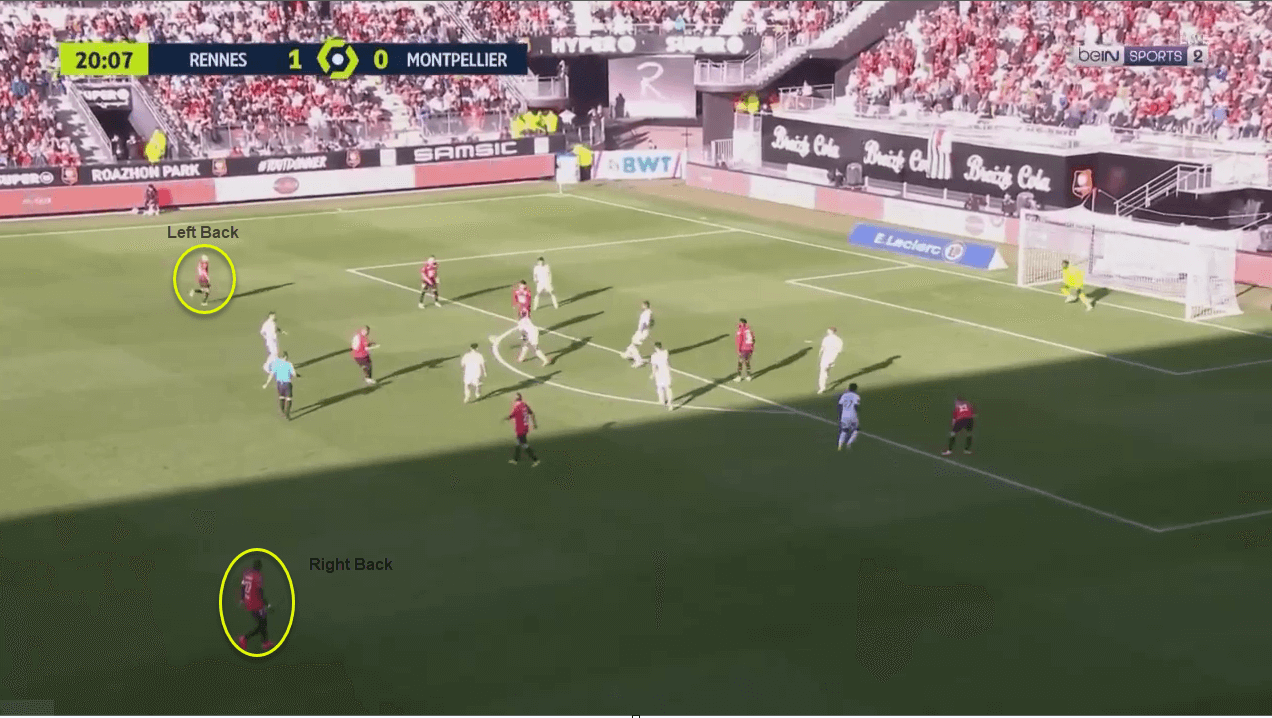
Pinning the opposition’s defence back in this way also provides defensive transition benefits as it makes it difficult for their opponents to transition into attack quickly because of the lack of width. Therefore, if Montpellier were to win the ball back in the image above and then wanted to counterattack the best option would be to play through the centre which then makes it easier for Rennes to counter-press.
Attack to defence
Playing high up the pitch and making the pitch as wide as possible is a high-risk approach. The purpose of the approach is that when they lose the ball they are further away from their goal and therefore close to the opponent’s goal as they attempt to win back possession.
However, this leaves Rennes at risk as they transition from attack to defence.
Here are two examples exposing how vulnerable Rennes can become when losing the ball.
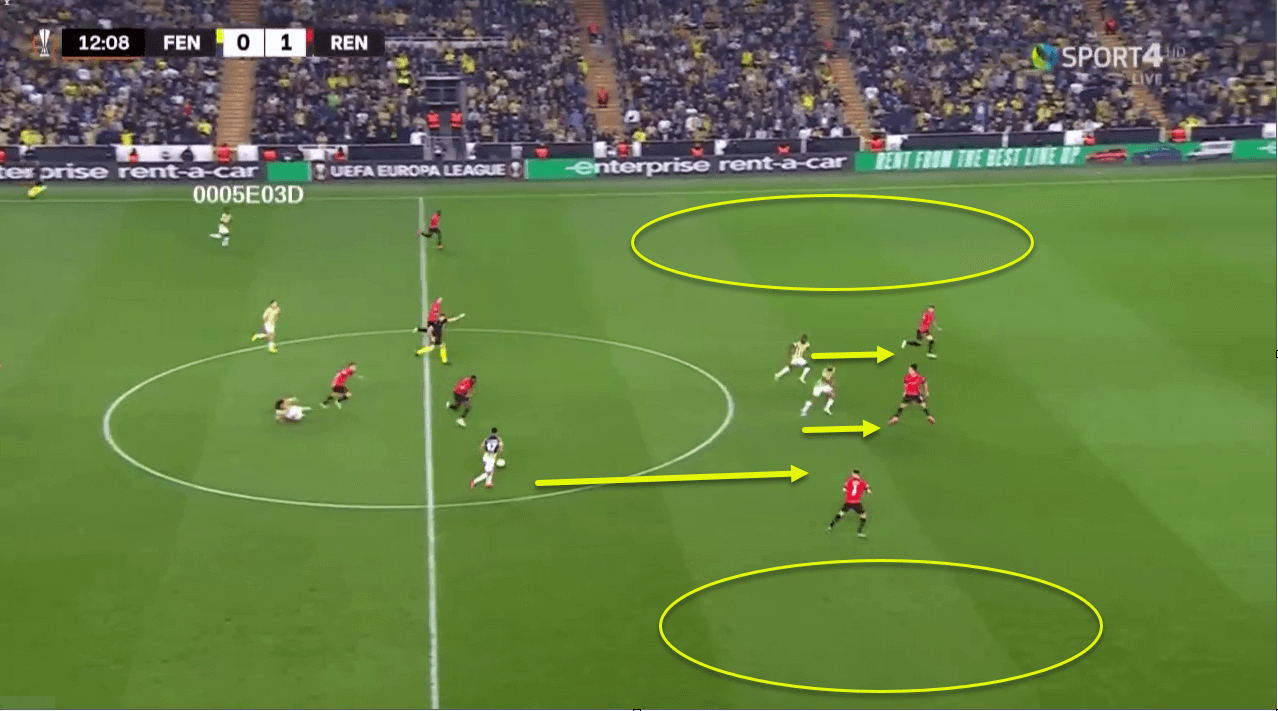
The image above is against Fenerbahçe in a UEFA Europa League match last week. Although they are not at a numerical advantage during this transition, they are left in a 3v3 situation with a ball carrier running at their defence.
Fenerbahçe are left with a lot of space to exploit both right- and left-hand channels because of the positions both fullbacks take up when they attack.
The next example against Lyon shows the space they leave open to attack because they play high up the pitch and look to dominate in the opposition’s half. Lyon’s quick turnover stops Rennes from switching into any defensive shape. This provides Lyon with more space to attack.
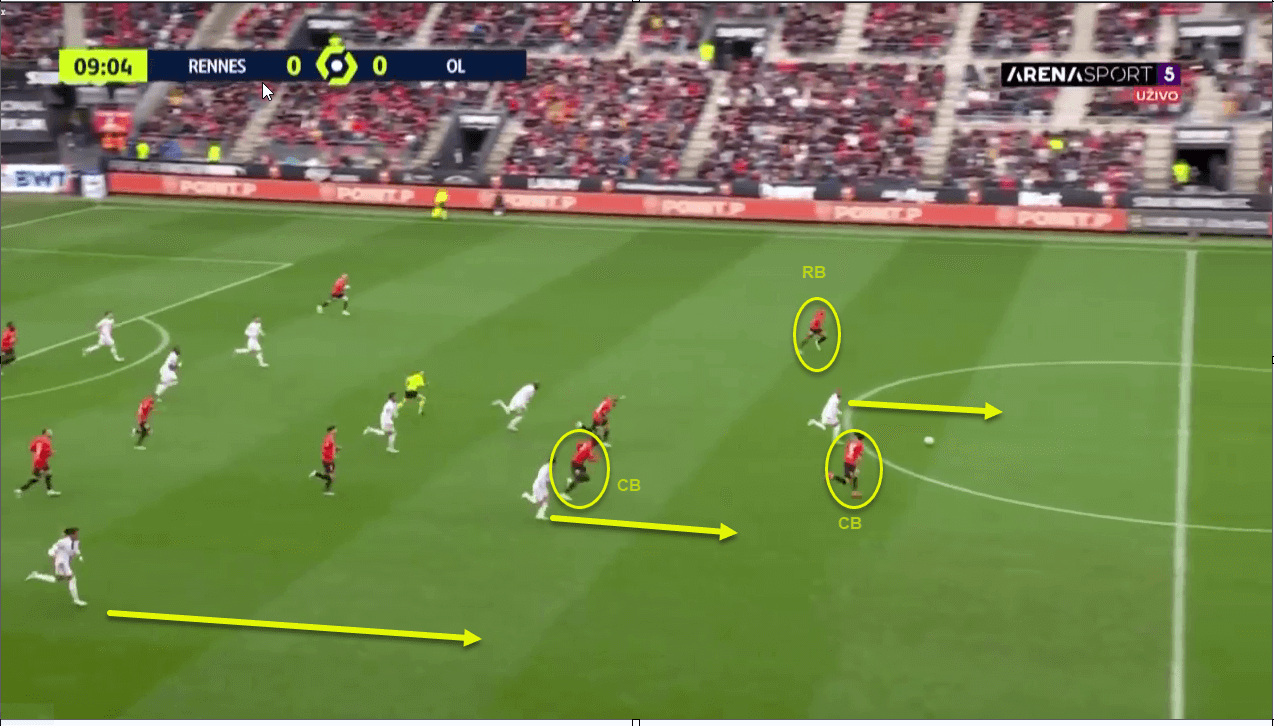
Defending approach
Under Bruno Genesio’s supervision, Rennes’ overall principle when defending is to make the pitch as small as possible both vertically and laterally. They are a team that presses against the ball with aggression and intensity.
The number of passes per defensive action they allow their opponents to make before engagement is 8.7, this is the fourth-lowest amount allowed in Ligue 1 so far this season. The number of duels, tackles, and interceptions they make per minute of their opponent’s possession is 5.9. These numbers confirm that Rennes are a team that likes to press and are active in their pursuit of possession when they defend.
The chart below shows the overall efficiency of every team’s pressing structure this season.
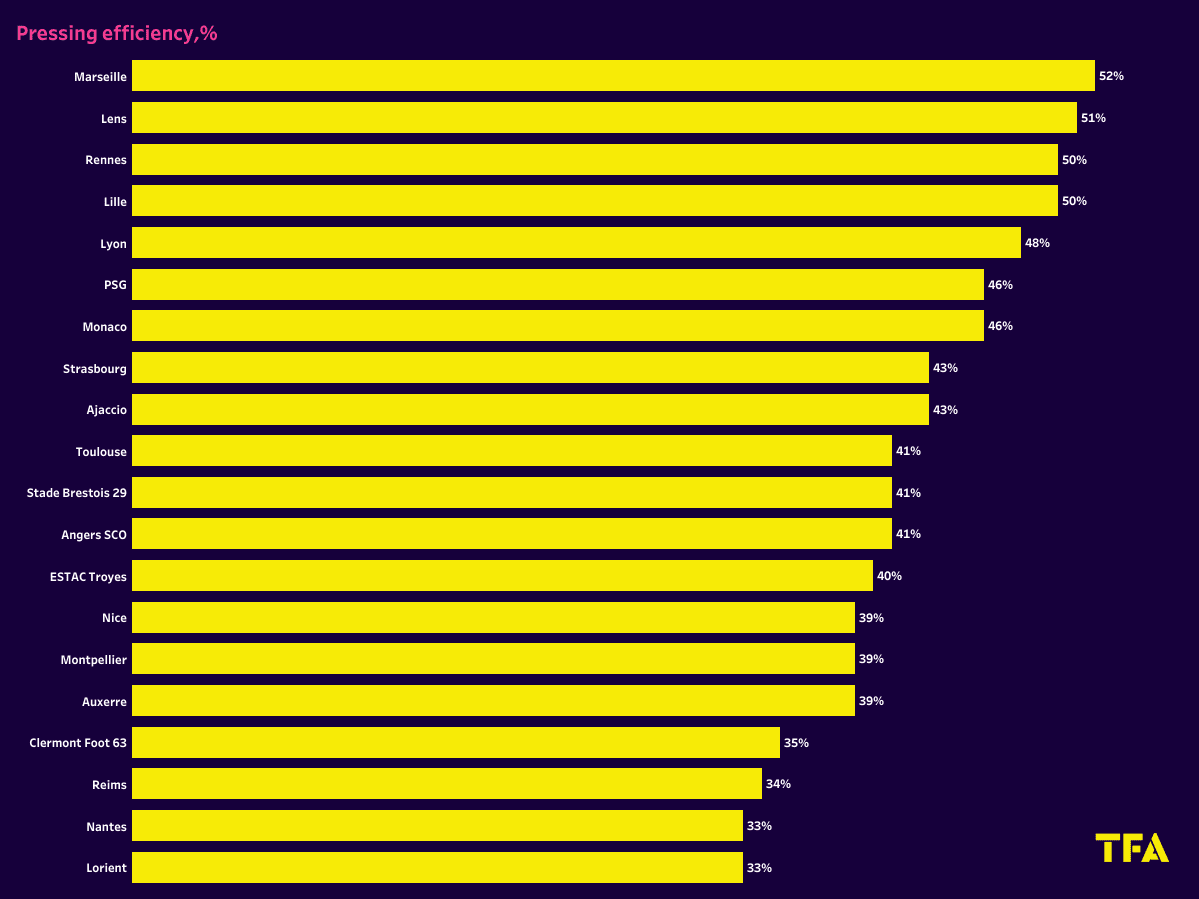
As you can see, the pressing approach that Rennes use is effective compared to the rest of the teams in France’s top flight. They have the third-highest pressing efficiency with 50%.
Defending High
How they press the ball changes depending on the area the opposition holds possession and the type of situation in which the other team have come to have possession.
When they lose possession high up the pitch they counter-press and look to win the ball back immediately because they attack with a high number of players in the opposition’s half
If the other team set up to play out from the goalkeeper and build up through the defence, Rennes set up like this in the image below.
The image shows how Rennes push high to stop their opponents in the build-up phase.
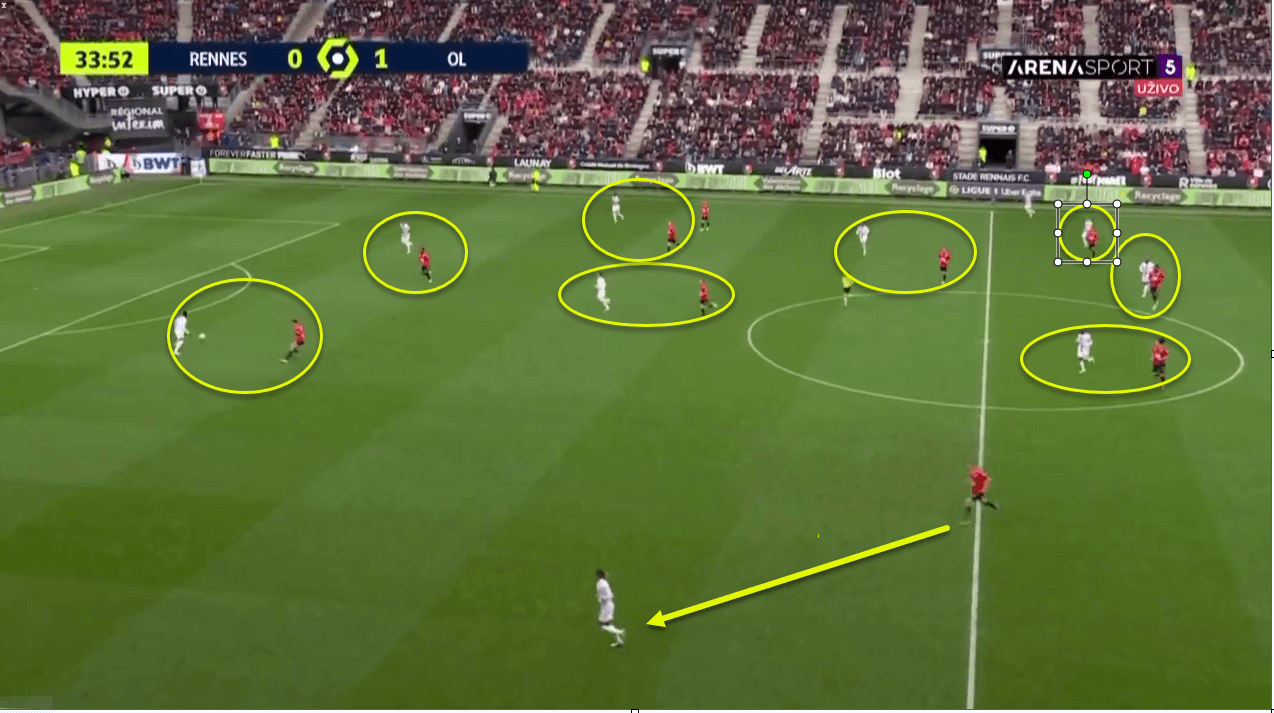
The focus here is pressing the ball in a 4-3-3 defensive shape with one player, while the other players apply a man-marking approach to all the viable passing options. This enables them to exert pressure on each ball carrier after every pass the opponent makes, without losing defensive shape.
Defending Deeper
When the team defend in a mid-block or a low block Bruno Genesio’s men switch their defensive approach.
Their pressing approach and defensive shape then become ball orientated. This means the player pressing the ball changes depending on the area the opposition hold possession, and so does the defensive shape.
As that player applies his press the rest of the keep a narrow and compact shape instead of pushing up and marking the surrounding passing option. The reason for this is to control the spaces out of possession and force their opponents to play into areas that allow them to expose weaknesses.
The next three images show how Bruno Genesio’s men transition between defensive shapes. They force Fenerbahçe towards their own goal and across the pitch and force them to start their build-up again.
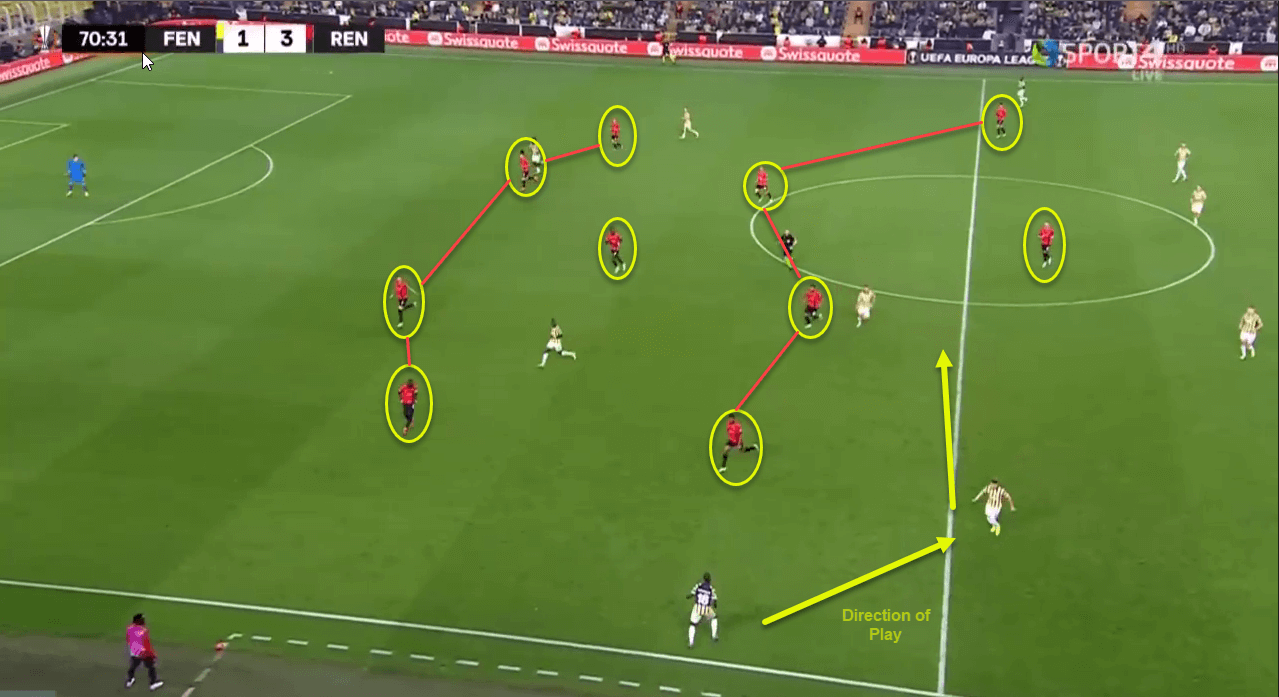
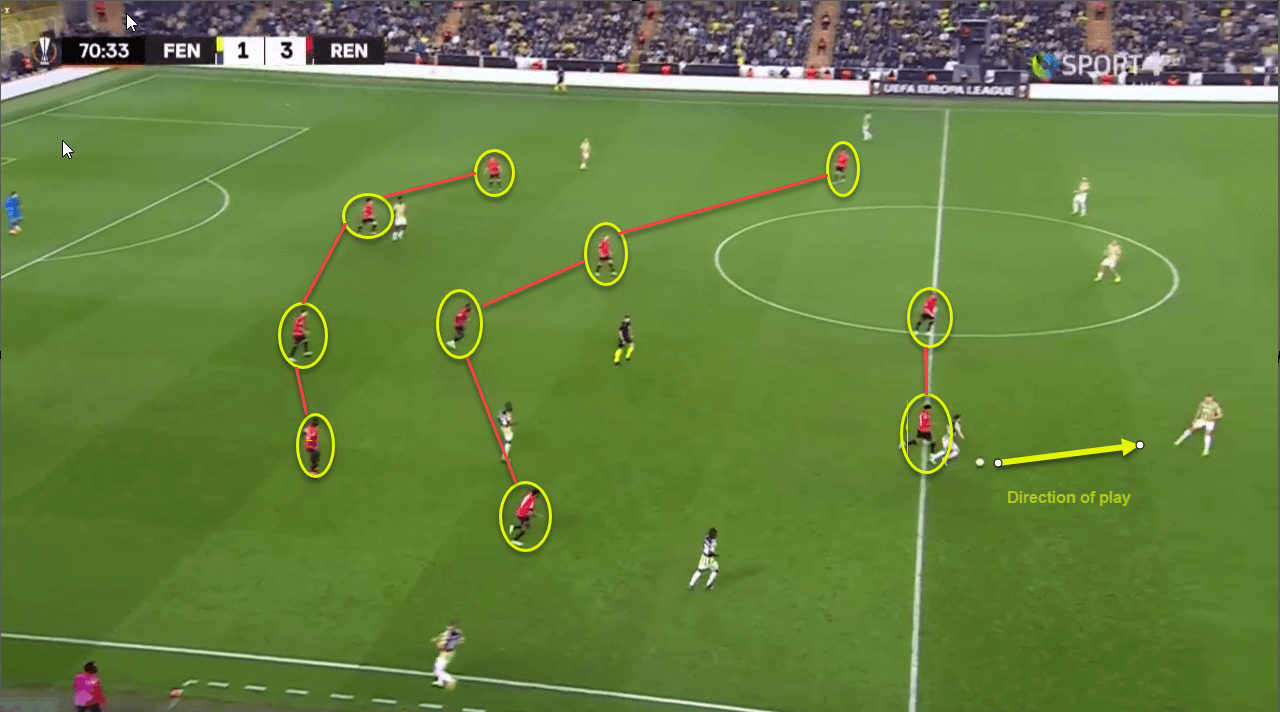
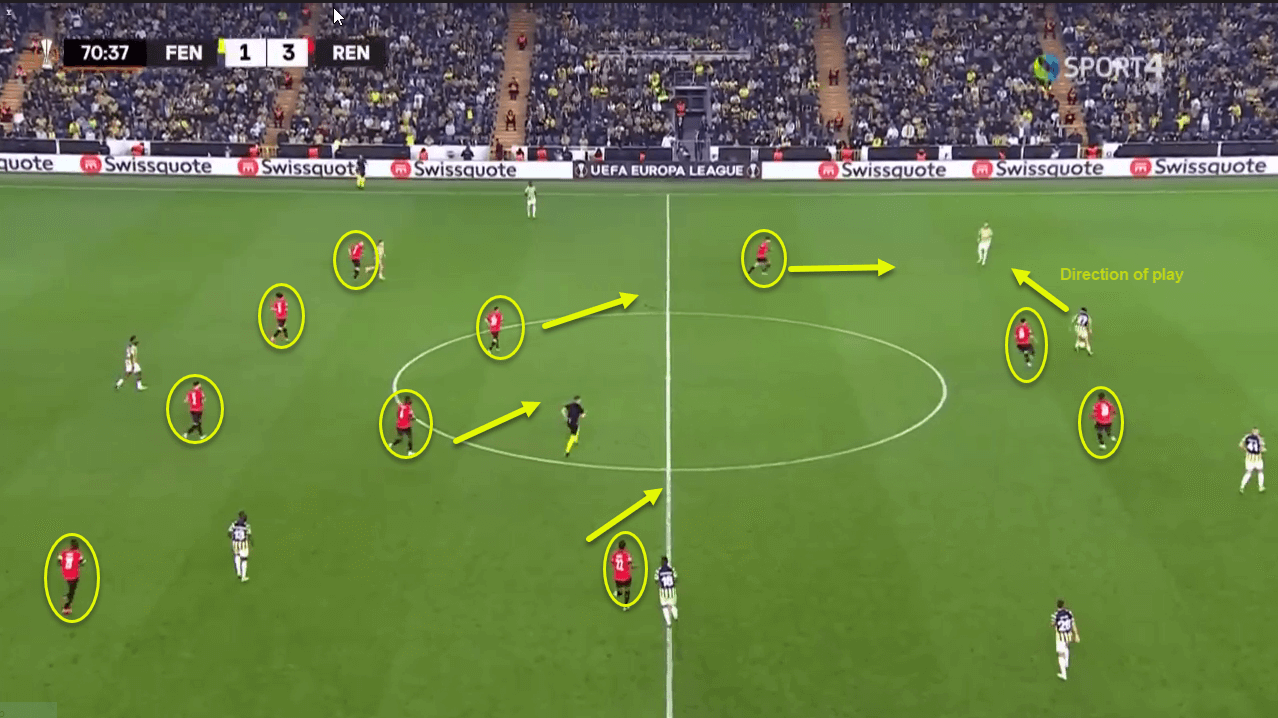
Defence to attack
When they win the ball, their transition to attack is focused through the wide areas.
Playing the ball progressively gives Rennes the chance to attack space with the first pass. It stops their opponents from being able to attempt to win the back straight away as it stretches and disjoints their defensive shape immediately.
These two examples show the first pass being played out wide in the first phase of their attacking transition. You can see how it pulls the defender across and leaves his defensive line. This creates more space in the centre.
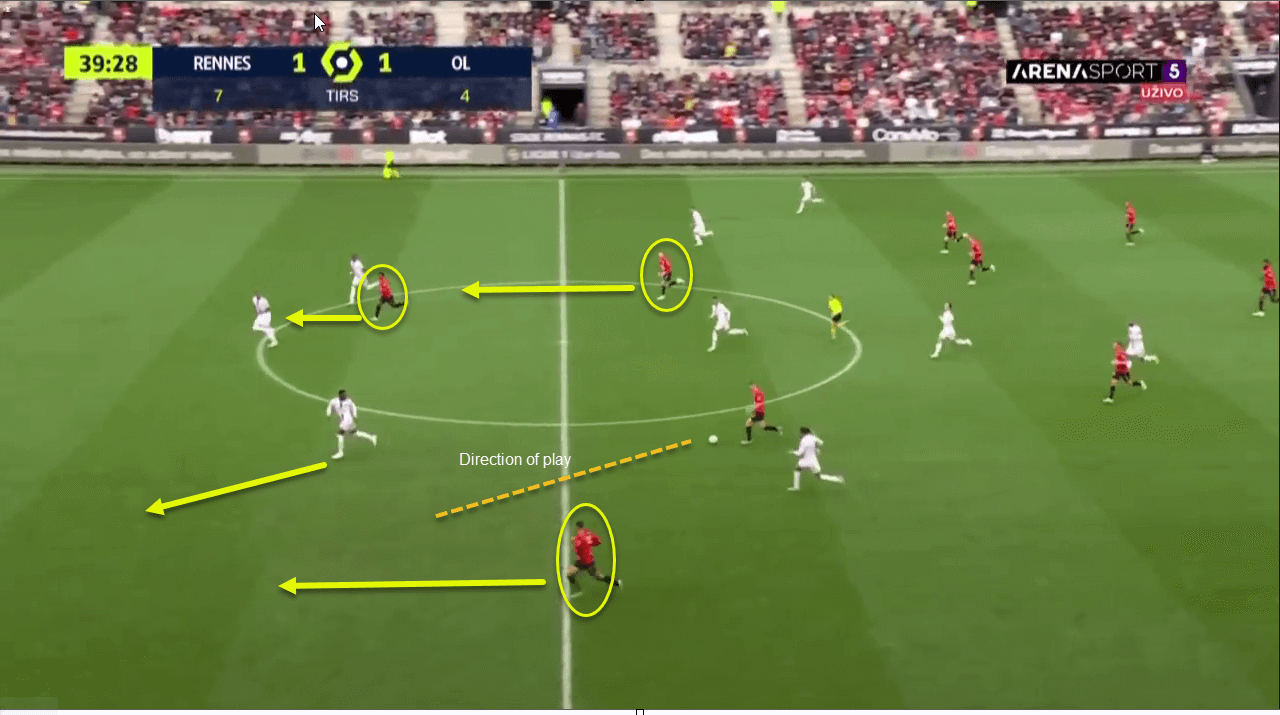
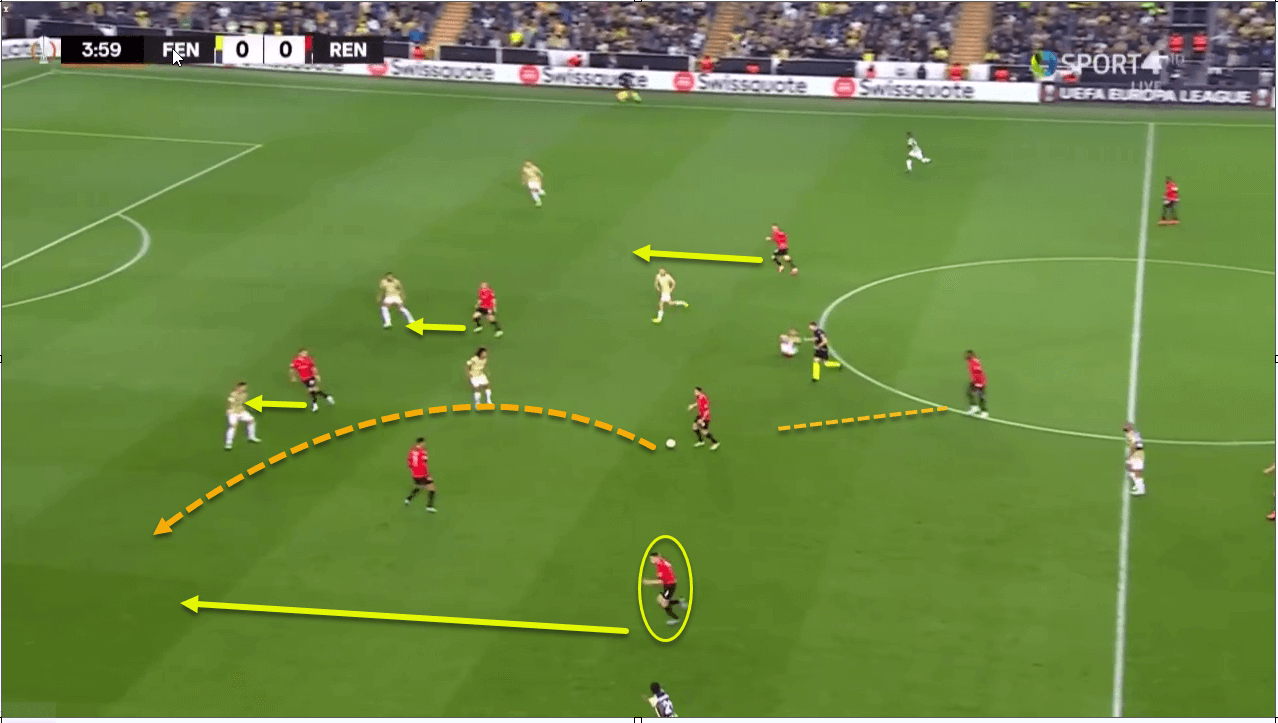
Rennes play more vertically in attacking transition. They aim to get the ball forward quicker and often try to enter the opposition’s penalty within 2-3 passes.
Conclusion
After a slow start to the season, Rennes are now back on track and should pose a challenge in the race for the UEFA Champions League places in France. They are very effective at implementing the style and approach the manager believes in. How far they go in this season’s Europa League could hinder their league position, especially considering some of their likely challengers won’t be in Europe in the second half of the season.
This is a tactical analysis scout report that focuses on the tactics deployed by Rennes this season. It displays the impact they have had on their current run of form. We have provided an analysis of the tactical traits within the team’s attacking stages, as well as highlighting key aspects within other defensive and transition phases.






Comments